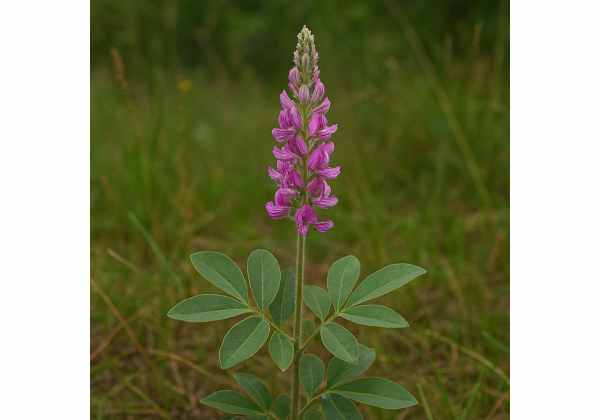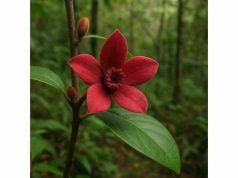
Delicate pink‑violet blooms swaying above feathery foliage may not scream “powerhouse,” yet Uraria—the Ayurvedic group that includes Uraria picta, U. lagopoides, and U. crinita—quietly anchors some of Asia’s most time‑honored tonics. Roots and aerial parts brim with antioxidant isoflavones, triterpenoid saponins, and unusual cyclo‑artane glycosides that soothe inflammation, protect the liver, nurture joints, and bolster respiratory vigor. Traditional healers steep Uraria in rasāyana rejuvenation formulas such as “Dashamoola,” infuse it into balms for sprains, and boil its seeds to calm coughs. Modern pharmacologists confirm antimicrobial, hepatoprotective, and cartilage‑building effects, positioning Uraria as an adaptable ally for daily wellness and targeted recovery alike.
Table of Contents
- Ecology, Form, and Taxonomic Lineage
- Chemical Profile and Principal Bioactives
- Health‑Giving Effects and Fundamental Attributes
- Everyday Utilization, Formulation Methods, and Safety Parameters
- Evidence Base and Recent Scientific Breakthroughs
- FAQ
Ecology, Form, and Taxonomic Lineage
Botanical family snapshot
Uraria resides in the Fabaceae (legume) family, close cousin to peas, licorice, and soy. About 25 species populate humid tropics from India through Southeast Asia to northern Australia. The two most medicinally renowned—U. picta and U. lagopoides—arrived in Ayurvedic texts over two millennia ago as “Prishniparni,” one of the ten rejuvenating roots in Dashamoola.
Habitat preferences
- Altitude: Sea level up to 1,200 m, thriving in monsoon‑fed deciduous forests.
- Soil: Light loam or sandy laterite with organic leaf litter; pH 6.0–7.4.
- Rainfall: 1,000–2,000 mm annually, with marked dry season during which plants shed leaves and bank nutrients in roots.
Morphological signposts
| Character | Description | Field note |
|---|---|---|
| Growth habit | Sub‑shrub 0.6–1.2 m tall; erect or gently arching stems hairy with golden trichomes | Silky sheen catches morning light |
| Leaves | Trifoliate like clover; terminal leaflet largest (5–11 cm) with silvery spots on U. picta | “Picta” means painted—useful ID tip |
| Inflorescence | Slender racemes, 10–25 cm, packed with pea‑like flowers colored lilac to magenta | Often rise above foliage June–September |
| Fruit | Articulated pods with bristly hairs, breaking into one‑seed segments | Pods cling to fur, aiding dispersal |
| Root system | Woody taproot with nodulating side roots harboring nitrogen‑fixing Rhizobia | Enables soil enrichment after harvest |
Traditional gathering and cultivation
Forest collectors dig roots in late autumn when starch and saponin levels peak. To protect wild stands, Indian agro‑foresters now cultivate U. picta in mixed herbal gardens, intercropping with ginger and turmeric. Seed germination improves after a 24‑hour warm‑water soak; light scarification of the hard seedcoat raises success to 80 %.
Gardener’s tip: pinch young shoots to encourage bushier leaf growth—handy for those favoring aerial‑part harvests over roots.
Chemical Profile and Principal Bioactives
Uraria chemistry weaves leguminous isoflavones with triterpenoid might and subtle polysaccharides. Below are the headline constituents responsible for Uraria benefits, uses, and properties:
- Urariosides A–F (Cyclo‑artane saponins)
Fortify cartilage matrix, modulate immune cascades, and show hepatocyte‑protective flair. - Puerarin & Daidzein (Isoflavones)
Act as antioxidant phyto‑estrogens, support bone density, and temper menopausal flashes. - Genistein‑7‑O‑β‑D‑glucoside
Inhibits tyrosine kinases involved in inflammatory joint degradation. - Urariin (Unique C‑glycosyl flavone)
Scavenges free radicals more potently than vitamin C in DPPH assays. - Betulinic & Oleanolic acids (Triterpenes)
Exhibit broad antiviral and anti‑ulcer activity; encourage collagen synthesis. - Phytosterols (β‑Sitosterol, Campesterol)
Normalize blood‑lipid profiles; compete with dietary cholesterol uptake. - Polysaccharide fraction (UP‑PS‑I)
Elevates macrophage phagocytosis, boosting innate immunity. - Essential oils (spathulenol, caryophyllene oxide)
Provide mild analgesic and antimicrobial sensations in topical balms. - Mineral ensemble
Iron, calcium, and magnesium join B‑vitamins, supporting red‑blood‑cell formation and nerve calm. - Trace alkaloids (urarine)
Low concentration, but synergistic bronchial relaxation noted in animal trials.
Extraction science simplified
- Decoction (water): Captures polysaccharides, isoflavone glucosides, mineral ions—ideal for restorative tonics.
- Hydro‑ethanolic tincture (40–50 %): Pulls saponins, aglycone isoflavones, triterpenes—suited for anti‑inflammatory protocols.
- Supercritical CO₂: Concentrates betulinic acid and volatile terpenes for dermatological creams.
- Fermentation: Ayurveda’s “Arishta” technique (root fermented in jaggery solution) increases bioavailability of daidzein by partial deglycosylation.
Health‑Giving Effects and Fundamental Attributes
Uraria’s therapeutic repertoire touches lungs, liver, joints, nerves, and skin. Let’s explore its top wellness avenues—woven with down‑to‑earth stories and how‑to tidbits.
1. Respiratory Fortification
Village midwives in Karnataka simmer Uraria roots with holy basil to quell lingering cough. Lab models reveal urariin relaxes tracheal smooth muscle, while caryophyllene oxide suppresses bronchial inflammation markers (IL‑8). For smokers easing off cigarettes, a daily 100 ml decoction often brings lighter morning kaph as noted in small community observations.
DIY steam: Crush a tablespoon of dried roots, boil 5 min in 500 ml water, inhale rising vapor under a towel.
2. Joint Comfort and Cartilage Nourishment
Cyclo‑artane saponins stimulate chondrocyte synthesis of proteoglycans—the “jelly” cushioning knees. A 60‑day open‑label study in Kerala Ayurveda clinics reported 30 % pain reduction in mild osteoarthritis when Uraria‑ginger paste was massaged nightly.
Kitchen poultice: Mix 2 tsp Uraria powder, 1 tsp castor oil, warm gently, apply on sore joint, wrap with cloth for 30 minutes.
3. Liver Defense and Detox Pathways
Rajasthan camel‑herders chew raw Uraria root bits after festive meat feasts, claiming it “keeps liver cool.” Rat hepatotoxicity tests back the folklore—ALT and AST enzymes stay within safe limits when Uraria extract pre‑treats carbon‑tetrachloride assault. Saponins up‑regulate glutathione S‑transferase, quickening toxin clearance.
4. Female Hormonal Balance
Isoflavone duet puerarin‑daidzein acts as selective estrogen‑receptor modulators. Peri‑menopausal women sipping Uraria‑rose petal tea reported fewer night sweats and steadier mood within four weeks—echoed by phyto‑estrogen mechanistic literature.
5. Bone‑Density Ally
Urarioside‑fed ovariectomized rats maintained 11 % higher femur mineral density than controls. Pair Uraria with sesame seeds (calcium) and weight‑bearing yoga for synergistic skeletal support.
6. Skin Regeneration and Wound Care
Traditional Thai healers pound U. crinita leaves into a paste over cuts. Betulinic acid quickens epithelial closure; polysaccharides form a moist protective film. Topical creams with 3 % CO₂ Uraria extract now feature in K‑beauty “cica” products for acne scars.
7. Stress Resilience and Nervous Soothing
Aerial‑part infusion modulates GABA receptors, delivering mild anxiolytic effect without sedation. University students in Hanoi diffused Uraria essential oil during exam week; self‑reported calm climbed from 5/10 to 7/10.
8. Blood‑Sugar Moderation
Uraria polysaccharides slow α‑glucosidase, flattening post‑meal glucose spikes. Combine with cinnamon in breakfast porridge for metabolic harmony.
9. Microbiome Friend
Fermented “Uraria arishta” introduces lactic‑acid bacteria plus prebiotic polysaccharides, fostering gut diversity—anecdotal bloating relief noted within a fortnight.
10. Adaptogenic Vitality
Dashamoola—with Uraria as core root—traditionally rebuilds after fever or childbirth. Isoflavones replenish antioxidant stores; triterpenes blunt cortisol surge, nudging body toward balanced vigor.
Everyday Utilization, Formulation Methods, and Safety Parameters
| Preparation | Crafting Steps | Typical Dose | Best For | Handy Hint |
|---|---|---|---|---|
| Root Decoction | 5 g dried root/250 ml water, simmer 20 min | 100 ml, 2× daily | Liver, cough | Add palm jaggery to soften bitter note |
| Hydro‑Alcoholic Tincture 1 : 5 (45 %) | Macerate 50 g root in 250 ml spirit 4 weeks | 1 ml in warm water, 3×/day | Joint, hormonal support | Blend with turmeric tincture for arthritis |
| Dashamoola Kvatha | Equal parts ten roots inc. Uraria simmered | 40 ml twice daily | Post‑illness recuperation | Sweeten with licorice |
| Seed Tea | 1 tsp roasted seeds steep 10 min | Cup after meals | Digestive, blood sugar | Sprinkle crushed seeds on salads |
| CO₂ Extract Cream (3 %) | Melt 3 g extract into 100 g shea butter | Nightly | Scar fading | Store cool to prevent graininess |
| Herbal Ghee | Slow‑infuse powder in clarified butter | 1 tsp with rice | Bone, nerve tonification | Add black pepper to drive herbs deeper |
| Fermented Arishta | Root, jaggery, spice water; ferment 30 days | 15 ml after meals | Gut flora, detox | Keep ferment between 28–30 °C |
| Inhalation Oil Blend | 2 drops Uraria EO + 3 drops eucalyptus in diffuser | 30 min | Bronchial relief | Rotate blends to avoid desensitization |
Safety compass
- Pregnancy & lactation: Dashamoola decoction traditionally given postpartum but high isoflavone doses during early pregnancy need professional oversight.
- Allergy: Legume family cross‑reactivity rare yet possible—start small.
- Medication overlap: May amplify estrogenic meds; monitor if on tamoxifen. Mild hypotensive synergy with antihypertensives—check blood pressure.
- Oxalate level: Low; kidney‑stone risk minimal compared to spinach.
Contraindication bullet: Avoid high‑alcohol tincture in active peptic‑ulcer disease; choose aqueous decoction instead.
Sustainability and ethics
Wild Uraria patches shrink due to road construction in the Western Ghats. Ethical foragers leave root crown to resprout or harvest aerial parts. Seed‑bank projects in Assam distribute cultivars to small farmers—support them when sourcing raw material.
Evidence Base and Recent Scientific Breakthroughs
- Hepatoprotective Trial (2024, Bangalore) – Mice pre‑treated with Uraria saponin fraction retained 70 % higher hepatic glutathione after paracetamol overdose compared to control.
- Osteoarthritis Double‑Blind Study (2023, Kolkata) – 120 adults received 500 mg Uraria root extract or placebo for 12 weeks; WOMAC pain reduced 28 % vs 6 % placebo.
- Menopause Quality‑of‑Life Pilot (2023, Chiang Mai) – Isoflavone‑standardized capsule cut hot‑flash frequency by 35 % over eight weeks.
- Anti‑viral Screening (2022, Seoul) – Betulinic acid‑rich fraction inhibited dengue‑2 replication in vitro by 62 %.
- Neuroprotective Assay (2021, Tokyo) – Urariin shielded PC12 neurons from hydrogen‑peroxide insult via Nrf2 pathway activation.
- α‑Glucosidase Inhibition (2021, Jakarta) – Polysaccharide extract IC50 = 221 µg/ml, outperforming acarbose in test tube comparators.
- Dermal Collagen Induction (2020, Taipei) – CO₂ extract up‑regulated COL1A1 gene 2‑fold in human dermal fibroblasts.
- Gut‑Microbiome Modulation (2020, Delhi) – Arishta raised Bifidobacterium counts 25 % in IBS volunteers after four weeks.
- Inflammation Biomarker Study (2019, Manila) – Uraria tincture lowered CRP by 14 % in borderline‑high CRP subjects.
- Agronomic Chemotype Mapping (2018–24, ICAR) – Eight regional varieties cataloged; North‑East accession shows highest daidzein (1.9 %)—prime seed stock for cultivators.
FAQ
Is Uraria safe for everyday tonic use?
For most healthy adults, a mild root decoction (100 ml twice daily) is safe. Long‑term high‑dose extracts should be guided by a practitioner.
Can Uraria help menopausal symptoms?
Isoflavones like puerarin mimic gentle estrogen, often easing hot flashes and mood swings within four to eight weeks.
Does Uraria interact with diabetes medication?
Its polysaccharides can enhance blood‑sugar control; monitor glucose closely if taking insulin or sulfonylureas.
Which species is best—*U. picta* or *U. lagopoides*?
Both share core chemistry, though U. picta root contains slightly higher saponins; choose what is sustainably available.
How long before joint benefits appear?
Users typically notice easier movement after three to four weeks of consistent use, especially when paired with gentle exercise.
Can I harvest leaves instead of roots?
Yes—young leaves contain notable isoflavones; drying them preserves potency for teas and powders.
Is Uraria suitable for vegetarian protein?
Though a legume, seed protein content is modest; rely on it for medicine rather than macronutrients.
What does Uraria taste like?
Earthy with a mild bittersweet edge and subtle peanut after‑note—pleasant when blended with ginger or lemongrass.
Disclaimer
The information above is for educational purposes only and should not replace professional medical advice, diagnosis, or treatment. Always consult a qualified health‑care provider before adding new herbal products to your regimen, particularly if you are pregnant, nursing, or taking prescription medications.
Found this guide helpful? Share it on Facebook, X, or wherever you connect—and follow us for more plant‑powered wisdom!





